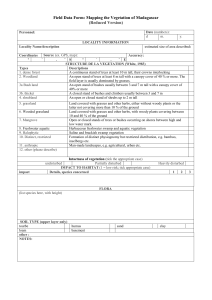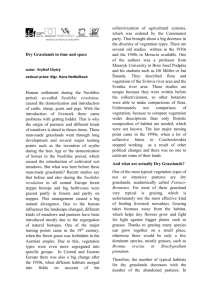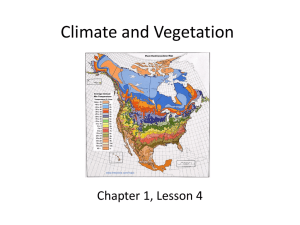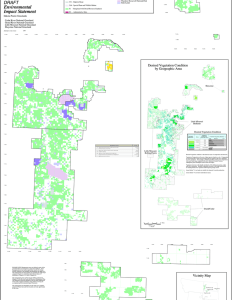Mapping Plains-Mesa Grasslands of New Satellite Data J.
advertisement
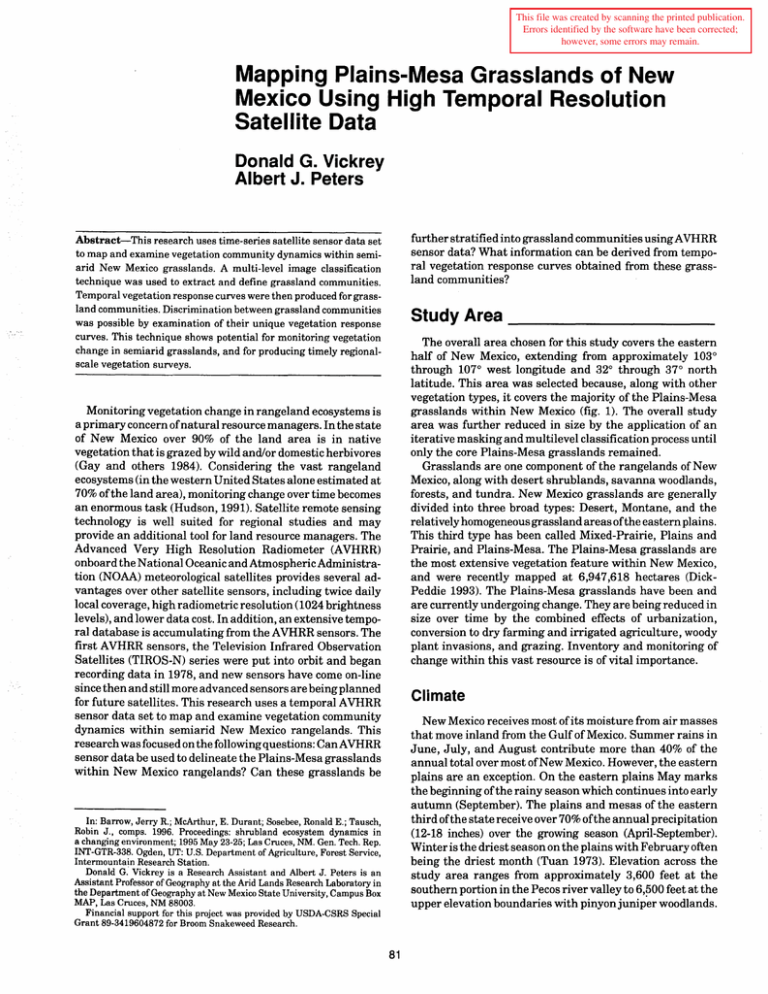
This file was created by scanning the printed publication. Errors identified by the software have been corrected; however, some errors may remain. Mapping Plains-Mesa Grasslands of New Mexico Using High Temporal Resolution Satellite Data Donald G. Vickrey Albert J. Peters further stratified into grassland communities using AVHRR sensor data? What information can be derived from temporal vegetation response curves obtained from these grassland communities? Abstract-This research uses time-series satellite sensor data set to map and examine vegetation community dynamics within semiarid New Mexico grasslands. A multi-level image classification technique was used to extract and define grassland communities. Temporal vegetation response curves were then produced for grassland communities. Discrimination between grassland communities was possible by examination of their unique vegetation response curves. This technique shows potential for monitoring vegetation change in semiarid grasslands, and for producing timely regionalscale vegetation surveys. Study Area _ _ _ _ _ _ _ __ The overall area chosen for this study covers the eastern half of New Mexico, extending from approximately 103 through 107 west longitude and 32° through 37° north latitude. This area was selected because, along with other vegetation types, it covers the majority of the Plains-Mesa grasslands within New Mexico (fig. 1). The overall study area was further reduced in size by the application of an iterative masking and multilevel classification process until only the core Plains-Mesa grasslands remained. Grasslands are one component of the rangelands of New Mexico, along with desert shrublands, savanna woodlands, forests, and tundra. New Mexico grasslands are generally divided into three broad types: Desert, Montane, and the relatively homogeneous grassland areas ofthe eastern plains. This third type has been called Mixed-Prairie, Plains and Prairie, and Plains-Mesa. The Plains-Mesa grasslands are the most extensive vegetation feature within New Mexico, and were recently mapped at 6,947,618 hectares (DickPeddie 1993). The Plains-Mesa grasslands have been and are currently undergoing change. They are being reduced in size over time by the combined effects of urbanization, conversion to dry farming and irrigated agriculture, woody plant invasions, and grazing. Inventory and monitoring of change within this vast resource is of vital importance. 0 0 Monitoring vegetation change in rangeland ecosystems is a primary concern of natural resource managers. In the state of New Mexico over 90% of the land area is in native vegetation that is grazed by wild and/or domestic herbivores (Gay and others 1984). Considering the vast rangeland ecosystems (in the western United States alone estimated at 70% ofthe land area), monitoring change over time becomes an enormous task (Hudson, 1991). Satellite remote sensing technology is well suited for regional studies and may provide an additional tool for land resource managers. The Advanced Very High Resolution Radiometer (AVHRR) onboard the National Oceanic and Atmospheric Administration (NOAA) meteorological satellites provides several advantages over other satellite sensors, including twice daily local coverage, high radiometric resolution (1024 brightness levels), and lower data cost. In addition, an extensive temporal database is accumulating from the AVHRR sensors. The first AVHRR sensors, the Television Infrared Observation Satellites (TIROS-N) series were put into orbit and began recording data in 1978, and new sensors have come on-line since then and still more advanced sensors are being planned for future satellites. This research uses a temporal AVHRR sensor data set to map and examine vegetation community dynamics within semiarid New Mexico rangelands. This research was focused on the following questions: Can AVHRR sensor data be used to delineate the Plains-Mesa grasslands within New Mexico rangelands? Can these grasslands be Climate New Mexico receives most of its moisture from air masses that move inland from the Gulf of Mexico. Summer rains in June, July, and August contribute more than 40% of the annual total over most ofNew Mexico. However, the eastern plains are an exception. On the eastern plains May marks the beginning of the rainy season which continues into early autumn (September). The plains and mesas of the eastern third of the state receive over 70% ofthe annual precipitation (12-18 inches) over the growing season (April-September). Winter is the driest season on the plains with February often being the driest month (Tuan 1973). Elevation across the study area ranges from approximately 3,600 feet at the southern portion in the Pecos river valley to 6,~00 feet at the upper elevation boundaries with pinyon juniper woodlands. In: Barrow, Jerry R.; McArthur, E. Durant; Sosebee, Ronald E.; Tausch, Robin J., comps. 1996. Proceedings: shrubland ecosystem dynamics in a changing environment; 1995 May 23-25; Las Cruces, NM. Gen. Tech. Rep. INT-GTR-338. Ogden, UT: U.S. Department of Agriculture, Forest Service, Intermountain Research Station. Donald G: Vickrey is a Research Assistant and Albert J. Peters is an Assistant Professor of Geography at the Arid Lands Research Laboratory in the Department of Geography at New Mexico State University, Campus Box MAP, Las Cruces, NM 88003. Financial support for this project was provided by USDA-CSRS Special Grant 89-3419604872 for Broom Snakeweed Research. 81 Figure 1-Overall and final study area. Vegetation AVHRR Satellite Data Previous studies have defined the potential dominant vegetation of the Plains-Mesa grassland as blue grama grass (Bouteloua gracilis). The potential associated species vary with geographic locality and may include: buffalo grass (Buchloe dactyloides), threeawn species CAristida spp.), western wheatgrass (Agropyron smithii), galleta (Hilariajamesii) , sideoats grama (Bouteloua curtipendula), little bluestem (Schizachyrium scoparium), Muhly species (Muhlenbergia spp.), black grama (Bouteloua eriopoda), hairy grama (Bouteloua hirsuta), tobosa (Hilaria mutica), burro grass (Scleropogon brevifolius), and others (Heerwagen in Weaver and Albertson 1956; Donart 1978; Dick-Peddie 1993). AVHRR data is characterized by low cost, high temporal (twice daily local coverage) and radiometric resolution (10 bit-1024 brightness levels), and a spatial resolution of 1.21 km2 at nadir. Nadir is defined as the path a line dropped from the satellite perpendicular to the earth would follow on the earth's surface. Another important feature of the AVHRR sensor for regional studies is its synoptic view. With a sensor scan angle of approximately ±55.4° the sensor images a 2,700 km swath perpendicular to nadir with each scan. The AVHRR sensor records energy in ~he visible red· (.58-.68 mm), near infrared (NIR) (.725-1.1 mm), middle infrared 82 (MIR) (3.55-3.93 mm), and thermal infrared (TIR) (10.5-11.5 mm) regions (Kidwell 1991). The data are collected at the same local sun time on each overpass with either a 7:30 ami pm or a 2:30 amIpm equatorial overpass depending on satellite orientation. Table 1-Core 1989 NOAA-10 data set. May 2 May 19 June 7 July 4 August 9 September 18 October 10 Vegetation Indices _ _ _ _ _ __ AVHRR data have been used extensively to delineate vegetation in global and regional studies. The primary method has been through the use of vegetation indices (VI). Vegetation indices are quantitative measures based on mathematical combinations ofreflectance data that attempt to measure vegetation biomass or vigor. Several indices have been developed such as the simple vegetation index (VI), and the normalized difference vegetation indices (NDVI) (Goward and others 1991). VI NDVI Image Nadir Julian date @Equatorial crossing Image date 89122 89139 89158 89185 89221 89261 89283 111°42' 117°35' 112°05' 112°05' 111°40' 113°30' 115°31' Scene IDNo. AV108912214494 AV108913915123 AV108915814505 AV108918514490 AV108922114474 AV108926114522 AV108928315000 Table 2-NOAA 10 data characteristics. Spectral range = (NIR-RED) (NIR-RED) (NIR+RED) The vegetation index used in this research is the soil adjusted vegetation index (SAVI). Satellite Bands (~) NOAA-10 1 2 3 4 5 .58 - .68 (RED) .725-1.10 (NIR) 3.55 -3.93 (MIR) 10.50 -11.50 (TIR) Band 4 repeated Used in this research X X X Rundquist 1994). The last step in the preprocessing procedure was to convert the data into a format suitable for further processing using personal computer based Earth Resources Data Analysis System (ERDAS) software (ERDAS 1990). J (NIR-RED) SAVI = (1 + L) (NIR + RED + L) SAVI was developed by A. R. Huete in 1988 to minimize soil influences on vegetation indices involving red and nearinfrared spectral data. These indices all exploit the characteristics of healthy, actively photosynthesizing vegetation. The chlorophyll in such vegetation absorbs much of the visible red light (RED) to carryon photosynthesis and the mesophyll tissue reflects infrared radiation (NIR). It is this difference between the absorbed RED and reflected NIR that is utilized by the vegetation indices. Additional Image Processing After the image preprocessing, additional image processing procedures were completed including: georeferencing and registration, image atmospheric standardization, and image masking (clouds, cloud shadows, and coniferous forested mountain areas). The final image processing step before image classification was to create a soil-adjusted vegetation index (SAVI) image for each image in the temporal data set. The RED and NIR bands, and the SAVI formula were used to create the vegetation index images for the overall study area. The seven SAVI images were then used in the classification process to define the vegetation within the overall study area. Methods _ _ _ _ _ _ _ _ __ Data Selection Seven images were selected for this research (table 1) from the NOAA-10 satellite (launched September 17, 1986). All images were from descending daytime overpass (7 :30 am equatorial crossing) satellites. The criteria for image selection were: image dates were spread evenly across the growing season, image nadir tracks were centered as much as possible on the study area, and images contained a minimum of clouds or ground fog in the study area. The images contain five spectral bands, three of which were utilized in this study (table 2). Multi-Level Image Classification 1st Level Classification The overall study area was "cut" from each of the seven SAVI images created in the previous image processing procedures. The images were then combined so that each SAVI image became one band in the resulting seven-band image. An unsupervised classification was then performed on the seven-band SAVI image. This classification produced an image containing 30 vegetation classes and an accompanying 30-class signature file. The signature file contained the statistical signature for each vegetation class (mean, standard deviation, etc.). The cloud and cloud shadow areas within this image were not classified and had a class value of zero. Preprocessing After image selection, image preprocessing steps were completed to extract the study area from the images, apply geometric and solar zenith angle corrections, and to complete radiometric calibrations. A VAX 8530 minicomputer and the Nebraska AVHRR Processing software (NAPS) were used to complete the preprocessing steps (Di and 83 2nd Level Post-Classification Grouping 3rd Level Classification The 30-class composite image was then grouped into five classes (table 3) to isolate the Plains-Mesa grasslands from the 30-class image. Existing vegetation maps, county soils maps, and personal knowledge guided this post-classification grouping process. The five class image isolating the Plains-Mesa grasslands is shown in figure 2. To establish vegetation class boundaries within the PlainsMesa grasslands (Class 3 in fig. 2), the Plains-Mesa grasslands were isolated from the other rangeland vegetation using a binary image masking procedure. Final Study Area The final core grassland study area was then 'cut' from the seven SAVI images containing only the Plains-Mesa grasslands. The images were combined so that each SAVI image became one band in the resulting seven-band image, an unsupervised classification was repeated on only the PlainsMesa grassland areas. A 7-class image was produced estab-'lishing vegetation class boundaries within the Plains-Mesa grasslands. Table 3-30-class to five class grouping. Original classes New class o o 1 2-8,10 9,11-22 23-28 1 2 3 4 29-30 5 Description Masked Areas Barren/Playas, Water, Sand Dune Chihuahuan Desert Shrub Plains-Mesa Grasslands Closed Canopy Pinyon Juniper Woodlands, Shinnery Oak & Sandscrub Woodland Irrigated Agriculture, Riparian, Remaining Coniferous Mountain Vegetation Field Work Extensive field work was completed within the final study area. To assist in this task a 7-class field image map and a Figure 2-Five class image of overall study area isolating Plains-Mesa grasslands (class 3). 84 Analysis of Grassland Classification _ _ _ _ _ _ _ __ Global Positioning System (GPS) were utilized on the field trips. The main goal for the field trips was to obtain location data for vegetation classes observed- in the field using the GPS. Additional goals were to obtain visual qualitative estimates of vegetation composition, and amount of covert bare soil in the areas where GPS points were taken. The location data and estimates of composition and cover were used as an aid for the final grouping of the 7-class vegetation classification, and for forming qualitative vegetation class descriptions. The 34 GPS points and accompanying vegetation descriptions were separated based on the class they were overlaying on the 7-class field image map. These data were then reviewed and summarized, and qualitative class descriptions were generated for the 7-class image map taken to the field. Before analysis the seven grassland classes were subjected to post-classification merging resulting in three vegetation classes corresponding to distinctive field classes. The three classes were a relatively homogeneous grassland class, a grassland/shrub mix class, and a juniper grassland class. In each of these classes, warm season grasses are the predominant vegetation. The classes are shown in table 4, and figure 3. Table 4-Post-classification merging into 3 classes. Original classes 1,2 3,4 5,6,7 New class 1 2 3 Class description Grasslandishru6 mix Homogeneous grassland Juniper grasslands Figure 3-Final study area grassland classes. 85 Grassland/Shrub Mix Class Description dates were plotted on the X-axis. A curve was then placed through the data points using a cubic-spline fitting algorithm. This curve represents a best estimate of the class mean vegetation response over the seven dates (fig. 4). The SAVI mean, standard deviation, and range for the three grassland classes are shown in table 5. The Grassland/Shrub Mix class (number 1 in fig. 3) consists of2,758 km 2 within the study area. The grassland/shrub mix class is found scattered at various sites throughout the study area and represents areas of transition. Blue grama grass dominates in this class with associated black grama and other grass species. This type occurs where brushy species such as mesquite (Prosopis glandulosa), and creosote (Larrea tridentata) have invaded degraded grasslands. It also occurs in areas where grasslands merge with fourwing saltbush (Atriplex canescens) communities such as those found around playa lakes. An example is the area surrounding the Laguna del Perro west ofVaughn, New Mexico. The grassland/shrub mix class also occurs in ecotonal/transition areas between the Plains-Mesa and desert grasslands found at the xeric lower elevation boundary of the study area. Analysis of Vegetation Response Curves In 1989 the mean annual precipitation across the study area was below normal, reflecting a spring and early summer drought that occurred across most of New Mexico. Growing season precipitation departure from normal for 1989 was approximately two inches below the thirty year normal across the study area (table 6). The monsoon rains that normally begin in May on the eastern plains did not begin until mid-July in 1989 (Climatological Data Annual Summary for New Mexico, NOAA 1989). We believe this can be seen in the three vegetation response curves as they do not begin their strong photosynthetic response (greenup) until July (Julian date 185) after the late monsoon rains. Homogeneous Grassland Class Description The Homogeneous Grassland class (number 2 in fig. 3) consists of 10,296 km2 within the study area. This relatively shrub- and tree-free grassland class occurs throughout the study area. Blue grama grass is the dominant vegetation in this class with various associated grass species. Curve Seasonal Patterns One way to interpret these curves is as an indication of temporal vegetation phenological activity across the study area. Because warm season grasses are the dominant vegetation in all three of these classes, the class phenological activity represented by the curves is predominantly due to the seasonal activity of grasses and not other associated Juniper Grassland Class Description The Junifer Grassland class (number 3 in fig. 3) consists of5,086 km within the study area. This class occurs throughout the study area at the mesic higher elevation boundary where the juniper grassland transitions to ajuniper savanna are marked by higher densities of pinyon pine (Pinus edulis), and one-seed juniper (Juniperus monosperma). Blue grama and sideoats grama grasses dominate in this class. 112 Associated Species 111 In grassland/shrub mix areas associated non-grass species are fourwing saltbush, mesquite, creosote, and broom snakeweed (Gutierrezia sarothrae). In juniper grassland areas sideoats and blue grama grasses dominate with scattered one-seed junipers and pinyon pine. Other associated species that may occur in minor amounts throughout the study area are Mormon tea (Ephedra spp.), yucca (Yucca spp.), various cacti species (opuntia spp.), winterfat(Ceratoides lanata), sumac (Rhus trilobata), andApache plume (Fallugia paradoxa). •• ~ G assl~ ndlSt rubN ixCI~ ss Homog ~neOl sGra ~slan ~Clas ~/JIJnlper I Gras ~Iand pass 110 z « w I ::E 109 ~ en en 108 en 5u 107 Vegetation Response Curves _ __ 106 The third objective of this research was to produce a temporal vegetation response curve for each of the three Plains-Mesa grassland classes: Grassland/Shrub Mix class, Homogeneous grassland class, and Juniper grassland class. To produce the vegetation response curves the SAVI mean value for each class was extracted for each of the seven images in the data set. These data were then entered into a spreadsheet and plotted graphically. The SAVI mean values were plotted on the Y-axis, and the corresponding Julian 105 / / I ""I' ~\ /;,~',";' - ~V " ~ / :6 .,.--1 ..... \ / /, - J l./ ~~ \ ~ / / 1/ ~I '-.1 - ~ \ V/ / ~ ;/ ~ II • /! 100 120 140 160· 180 200 220 240 260 280 300 JUUAN DATE Figure 4-Grassland community response curves representing class means for seven dates through the 1989 growing season. 86 Table 5-SAVI data statistics-mean, standard deviation, and range for final study area three grassland classes. Image date Mean Standard deviation has the lowest and the Homogeneous grassland class curve falls in between. We believe these differences in SAVI mean values are due to differences in the amount of cover or conversely the amount ofbare soil between the three classes. The qualitative class descriptions recorded in the field indicate the greatest amount of bare soil in the Grassland/ Shrub Mix class and the least in the Juniper grassland class. Bare soil in the Homogeneous grassland class fell in between these two. Range Class 1-Grassland/Shrub Mix Class May 2,1989 106.21 1.026 May 19, 1989 105.462 0.871 June 7,1989 106.229 0.977 July 4,1989 105.572 1.032 August 9, 1989 106.315 1.628 September 18, 1989 108.416 1.936 October 10, 1989 107.824 1.634 Class 2-Homogeneous Grassland Class May 2, 1989 107.632 1.198 May 19, 1989 106.591 0.955 June 7, 1989 107.626 1.139 July 4,1989 107.050 1.226 108.449 1.848 August 9, 1989 September 18, 1989 109.142 1.457 October 10, 1989 108.274 1.261 105-118 100-113 104-118 104-115 104-123 104-117 104-116 Class 3-,Juniper Grassland Class May 2,1989 107.983 1.340 May 19,1989 107.003 0.991 June 7,1989 108.046 1.149 July 4,1989 1.345 107.421 August 9, 1989 110.110 1.883 September 18, 1989 111 .175 1.756 October 10, 1989 109.880 1.569 105-117 104-113 104-114 104-113 104-121 105-121 105-117 102-114 98-114 103-112 103-112 103-113 102-116 104-113 Conclusions Table 6-Study area precipitation departure from normal in 1989 (30 year normal 1951-1980). Climate division 1989 growing season (May-October) in. Northeast Plains (3) Central Valley (5) Central Highlands (6) Southeast Plains (7) Southern Desert (8) +1.27 -1.19 -1.69 -2.48 -1.13 ---------------------------- The focus of this research was on the development of techniques for the delineation of Plains-Mesa grasslands and on the use of temporal vegetation response curves as an indicator of vegetation activity within the grassland classes. The Plains-Mesa grasslands are the most extensive vegetation feature within the state of New Mexico and their continued health is important economically and aesthetically to the citizens of New Mexico. We believe an initial grassland inventory and assessment of condition should be conducted, and the grasslands should be monitored on a regular basis. In particular, the ecotonal xeric and mesic boundaries of the Plains-Mesa grasslands should be monitored closely. Any expansion or contraction of the PlainsMesa grasslands will be evident as change within these regions. We believe the techniques developed with this research are a step towards monitoring the health of the New Mexico Plains-Mesa grasslands. References 1989 total departure in. ----------------------------- Di, Liping; Rundquist, Donald C. 1994. A One-Step Algorithm for Correction and Calibration of AVHRR Level 1b Data. Photogrammetric Engineering & Remote Sensing. 60.2: 165-171. Dick-Peddie, William A. 1993. New Mexico Vegetation Past Present and Future. Albuquerque, NM: University of New Mexico Press. Donart, Gary B.; Sylvester, Donell; Hickey, Wayne. 1978. A Vegetation Classification System for New Mexico, U.S.A. Proceedings of the First International Rangeland Congress. 488-490. ERDAS. 1991. ERDAS User's Guide. Atlanta, Georgia: ERDAS Inc. Gay, Charles W., Jr.; Dwyer, Don D.; Allison, Chris; Hatch, Stephen; Schickedanz, Jerry. 1984. New Mexico Range Plants. New Mexico State University Cooperative Extension Service Circular #374. Las Cruces, NM: NMSU. Goward, Samuel N.; Markham, Brian; Dye, Dennis G.; Dulaney, Wayne; Yang, Jingli. 1991. Normalized Difference Vegetation Index Measurements from the Advanced Very High Resolution Radiometer. Remote Sensing of Environment. 35: 257-277. Hudson, Wendy E., ed.1991. Landscape Linkages and Biodiversity. Washington, DC: Island Press. Huete, A. R. 1988. A Soil-Adjusted Vegetation Index (SAVI). Remote Sensing of Environment. 25: 295-309. Kidwell, Katherine B. 1991. NOAA Polar Orbiter Data Users Guide. Washington, DC: NOAA Environmental Data and Information Service, National Climatic Center, Satellite Data Services Division. NOAA. 1989. Climatological Data Annual Summary-New Mexico. 28: 1-13. Tuan, Yi-Fu; Everard, Cyril E.; Widdison, Jerold G.; Bennett, Ivan. 1973. The Climate of New Mexico. Santa Fe: New Mexico State Planning Office. Weaver, J. E.; Albertson, F. W. 1956. Grasslands ofthe Great Plains Their Nature and Use. Lincoln, Nebraska: Johnsen Publishing Co. +0.25 -1.37 -2.70 -2.77 -1.59 vegetation such as shrubs in the grassland/shrub mix class or trees in the juniper grassland class. All three classes exhibit similar seasonal vegetation response patterns reaching an early season peak on June 7 (Julian date 158) and then decreasing rapidly due to the late arrival of the monsoon rains and increasing summer temperatures. After the monsoon rains began in mid-July, the warm season grasses began their greenup reaching a peak on September 18 (Julian date 261) and then began to fall again due to decreasing temperatures and associated fall season vegetation senescence across the study area. Curve Amplitude A second way to interpret these curves is as an indication of differences in cover between the three grassland classes. The SAVI curve representing the Juniper grassland class consistently has the highest mean values across the growing season, while the curve for the Grassland/Shrub Mix class 87



